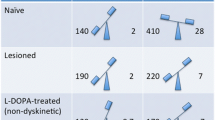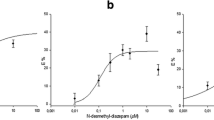Summary
Dopaminergic binding sites were studied in slices from rat striatum incubated in a physiological medium and using the two highly selective ligands 3H-apomorphine and 3H-domperidone. The clearly biphasic or stretched inhibition of the specific binding of these two ligands by domperidone or apomorphine, respectively allowed to define three distinct classes of binding site. It was demonstrated, by comparing the binding of the 3H-ligand added at the beginning of slice incubation or just before homogenisation of tissue and filtration, that the “specific” bindings only occurred during the incubation of slices. The inhibition constants (K i values) of dopaminergic agents for the three classes of binding site as also the dissociation constants (K d values) of 3H-ligands and the maximal capacity (B max) of the three classes of binding site were closely similar to those of binding sites previously demonstrated on rat striatal membranes, namely D-2, D-3 and D-4 sites (Sokoloff et al. 1980a, b). Their identification on a preparation in which the cellular organisation is largely preserved rules out the possibility that these sites represent an artifact due to membrane preparation.
Unexpectedly the addition of guanyl nucleotides like GTP or GppNHp to the slice preparation decreased the binding of 3H-apomorphine to the high affinity sites (particularly to the D-2 sites) while D-4 site binding was correspondingly increased. The guanylnucleotide effect apparently took place before cell disruption and occurred at concentrations similar to those required in striatal membrane preparations. These observations, together with those indicating the presence of high affinity binding sites for dopaminergic agonists in intact striatal cells, suggest that a putative nucleotide regulatory unit of dopamine receptors, is not fully occupied by intracellular GTP but could be interacted with from the external face of the cell membrane.
Similar content being viewed by others

References
Baudry M, Martres MP, Schwartz JC (1977) In vivo binding of 3H-pimozide in mouse striatum: effects of dopamine agonists and antagonists. Life Sci 21:1163–1170
Baudry M, Martres MP, Schwartz JC (1978) 3H-Domperidone and 3H-pimozide: more specific ligands for dopamine receptors studied in vitro and in vivo. In: Usdin E., Kopin IJ, Barchas J (eds) Catecholamines: basic and clinical frontiers, vol 1. Pergamon Press, New York, pp 565–567
Baudry M, Martres MP, Schwartz JC (1979) 3H-domperidone: a selective ligand for dopamine receptors. Naunyn-Schmiedebergs Arch Pharmacol 308:231–237
Creese I, Usdin T, Snyder SH (1979a) Guanine nucleotides distinguish between two dopamine receptors. Nature 278:577–578
Creese I, Usdin TB, Snyder SH (1979b) Dopamine receptor binding regulated by guanine nucleotides. Mol Pharmacol 16:69–76
Dam Trung Tuong M, Garbarg M, Schwartz JC (1980) Pharmacological specificity of brain histamine H2-receptors differs in intact cells and cell free preparations. Nature 287: 548–551
Freedman SB, Poat JA, Woodruff GN, (1981) Effect of guanine nucleotides on dopaminergic agonist and antagonist affinity for [3H] sulpiride binding sites in rat striatal membrane preparations. J Neurochem 37:608–612
Hamblin MW, Creese I (1982a) Phenoxybenzamide treatment differentiates dopaminergic 3H-ligand binding sites in bovine caudate membranes. Mol Pharmacol 21:44–51
Hamblin MW, Creese I (1982b) Heat treatment mimics guanosine-5′-triphosphate effects on dopaminergic 3H-ligand binding to bovine caudate membranes. Mol Pharmacol 21:52–56
Kebabian JW, Chen TC, Cote TE (1979) Endogenous guanyl nucleotides: components of the striatum which confer dopamine sensitivity to adenylate cyclase. Commun Psychopharmacol 3: 421–428
Köhler C, Fuxe K, Ross SB (1981) Regional in vivo binding of [3H]-N-propyl-norapomorphine in the mouse brain, evidence for labelling of central dopamine receptors. Eur J Pharmacol 72: 397–402
Köhler C, Ogren SO, Haglund L, Angeby T (1979) Regional displacement by sulpiride of [3H]-spiperone binding in vivo. Biochemical and behavioural evidence for a preferential action on limbic and nigral dopamine receptors. Neuroscience Lett 13:51–56
Laduron P, Janssen PFM, Leysen JE (1978) Spiperone: a ligand of choice for neuroleptic receptors. 2. Regional distribution and in vivo displacement of neuroleptic drugs. Biochem Pharmacol 27:317–321
Lowry O, Rosebrough NJ, Farr AL, Randall RJ (1951) Protein measurement with the folin phenol reagent. J Biol Chem 193:265–275
Martres MP, Sokoloff P, Delandre M, Schwartz JC, Protais P, Costentin J (1984) Selection of dopamine antagonists discriminating various behavioral responses and radioligand binding sites. Naunyn-Schmiedeberg's Arch Pharmacol 325:102–115
Rodbell M (1980) The role of hormone receptors and GTP-regulatory proteins in membrane transduction. Nature 284:17–22
Seeman P (1980) Brain dopamine receptors. Pharmacol Rev 32: 229–313
Seeman P (1982) Nomenclature of central and peripheral dopaminergic sites and receptors. Biochem Pharmacol 31:2563–2568
Sceman P, Chau-Wong M, Tedesco J, Wong K (1975) Brain receptors for antipsychotic drugs and dopamine: direct binding assays. Proc Nat Acad Sci USA 72:4376–4380
Seeman P, Lee T, Chau-Wong M, Tedesco J, Wong K (1976) Dopamine receptors in human and calf brains, using [3H] apomorphine and an antipsychotic drug. Proc Nat Acad Sci USA 73:4354–4358
Sibley DR, De Lean A, Creese I (1982) Anterior pituitary dopamine receptor. Demonstration of interconvertible high and low affinity states of the D-2 dopamine receptor. J Biol Chem 257: 6351–6361
Sokoloff P, Martres MP, Schwartz JC (1980a) Three classes of dopamine receptor (D-2, D-3, D-4) identified by binding studies with 3H-apomorphine and 3H-domperidone. Naunyn-Schmiedebergs Arch Pharmacol 315:89–102
Sokoloff P, Martres MP, Schwartz JC (1980b) 3H-Apomorphine labels both dopamine post-synaptic receptors and autoreceptors. Nature 288:283–286
Sonne O, Berg T, Christoffersen T (1978) Binding of 125I-labeled glucagon and glucagon stimulated accumulation of adenosine 3′∶5′-monophosphate in isolated intact rat hepatocytes. Evidence for receptor heterogeneity. J Biol Chem 253:3203–3210
Taft WC, Abdel-Latif AA, Akhtar RA (1980) [3H] Quinuclidinyl benzilate binding to muscarinic receptors and [3H] WB-4101 binding to alpha-adrenergic receptors in rabbit iris. Comparison of results in slices and microsomal fractions. Biochem Pharmacol 29:2713–2720
Van Buskirk R, Dowling JE (1981) Isolated horizontal cells from carp retina demonstrate dopamine-dependent accumulation of cyclic AMP. Proc Nat Acad Sci (USA) 78:7825–7829
Zahniser NR, Molinoff PB (1978) Effect of guanine nucleotides on striatal dopamine receptors. Nature 275:453–455
Author information
Authors and Affiliations
Rights and permissions
About this article
Cite this article
Martres, M.P., Sokoloff, P. & Schwartz, J.C. Dopaminergic binding sites in rat striatal slices and the action of guanyl nucleotides. Naunyn-Schmiedeberg's Arch. Pharmacol. 325, 116–123 (1984). https://doi.org/10.1007/BF00506190
Received:
Accepted:
Issue Date:
DOI: https://doi.org/10.1007/BF00506190



